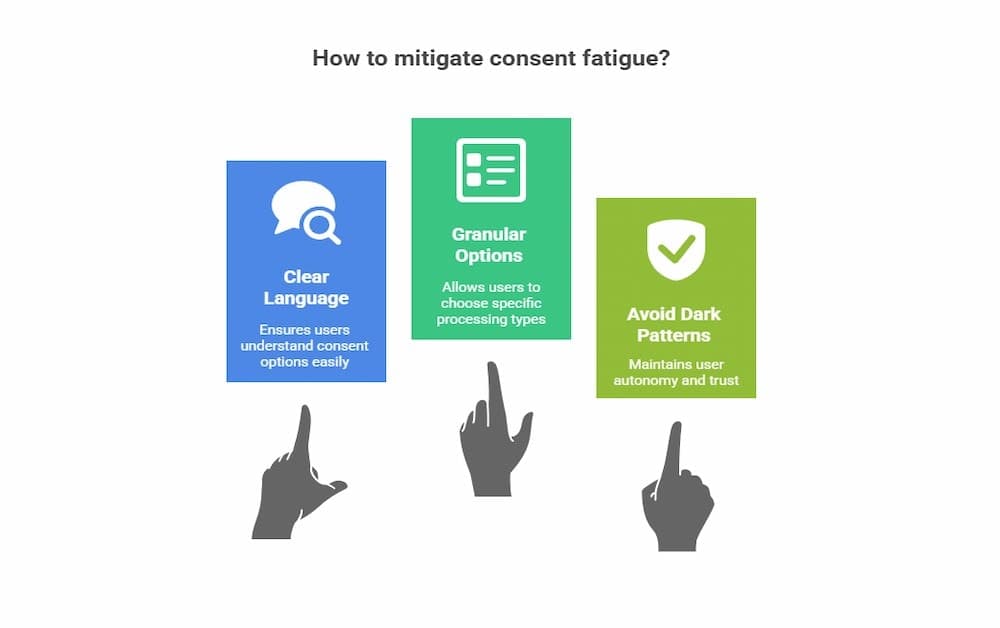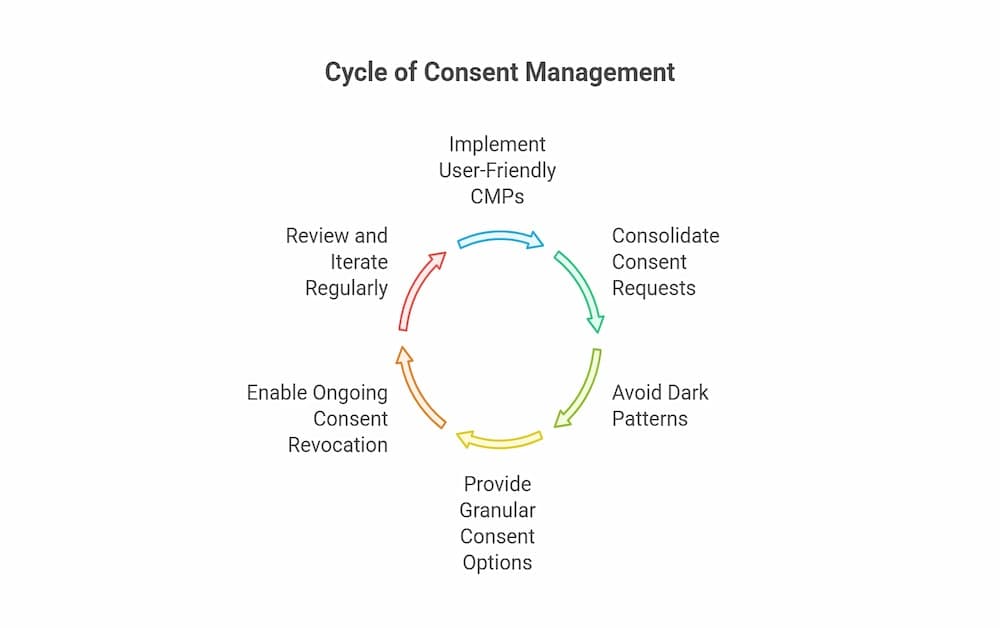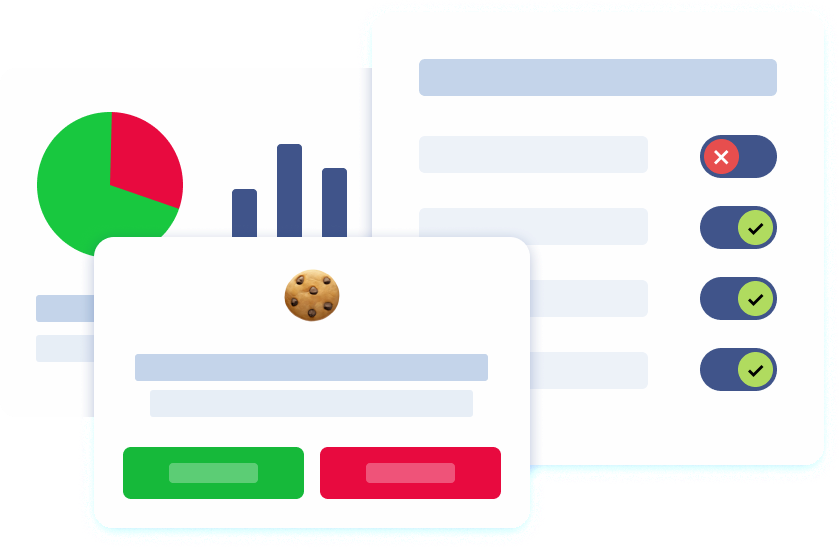Introduction
Consent fatigue refers to the phenomenon where users become desensitized or exhausted by repeated consent requests, leading to disengagement or careless acceptance. As internet users are exposed to thousands of consent prompts annually—from cookie banners to privacy notices—they start to prioritize convenience over understanding, undermining valid consent and resulting in inaccurate data.
This overload harms both the consumer side and business interests. Users may refuse consent or give it without reading, compromising data privacy and eroding user autonomy. Repeated consent requests and poor UX can also raise privacy concerns among users, as they may feel their personal information is not being handled responsibly. Simultaneously, businesses suffer from poor user engagement, unreliable analytics, and potential non‑compliance with privacy regulations. Consent fatigue can further negatively impact businesses’ revenue streams by reducing the amount of data collected and diminishing user trust, which in turn affects marketing effectiveness and monetization.
Understanding this exhaustion is key. In the age of intrusive data collection and processing, consent banners, and cookie consent banners, it is essential to identify how to combat consent fatigue without compromising legal obligations or user trust. Adopting best practices to avoid consent fatigue is crucial for maintaining compliance and fostering user trust.
Understanding Consent Banners
Consent banners are the front line in collecting informed consent (often referred to as a cookie banner) for various data processing activities—from placing cookies to tracking behavior. Collecting consent is crucial for data analytics and compliance. However, their ubiquity often backfires: too many banners lead to fatigue from exposure to consent banners, where users either mechanically hit “reject” or “accept all” to get on with browsing. This mechanical process undermines the meaningful act of giving consent, making it less voluntary and informed. Over-exposure to consent banners leads to user fatigue and diminished trust in privacy practices.
Poor privacy UX practices—tiny fonts, legalese, or hidden granular options—worsen this fatigue. Users feel manipulated into giving up their personal data, unaware of the implications on user behavior or consumer data processing.
To mitigate consent fatigue:
- Use clear, concise language in cookie banners and privacy notices.
- Offer granular consent options, letting users opt in to specific processing types.
- Avoid dark patterns or manipulative consent model designs that erode user autonomy.
These consent preferences—when transparent and manageable—empower users to provide consent meaningfully and reduce fatigue.

The Importance of Data Privacy
Data privacy goes beyond legal compliance; it’s about preserving user trust, enabling informed decisions, and respecting user choices. Under regulations like GDPR and CCPA, as well as other data privacy regulations, informed consent and explicit consent are only considered valid consent if obtained freely and clearly. Legal obligation is another lawful basis for data processing under data privacy regulations, allowing processing when required to comply with a legal requirement. Businesses must offer users the chance to grant consent or reject cookies, and the ability to revoke consent later. It is also essential to respect the rights of the data subject, ensuring that individuals have control over their data and that their rights are upheld throughout the consent process.
Maintaining strong data ethics also contributes to business value:
- Higher user engagement comes from transparent data collection practices, including understanding that hashed data isn’t truly anonymous.
- Avoiding poor data analytics, from skewed or missing data caused by rushed consent.
- Alignment with privacy laws prevents fines and enhances reputation.
To educate users, organizations should provide plain-language explanations and examples of sensitive data uses, empowering users to make informed decisions about their data. This approach not only reduces the anxiety behind relentless consent prompts but also fosters user understanding, which is crucial for compliance and building trust.
Data Protection Regulations
Data protection regulations are at the heart of how organizations approach informed consent, opt-out requirements, and manage consent fatigue. Laws like the European Union’s General Data Protection Regulation (GDPR) and similar frameworks worldwide have set a high bar for how businesses must handle consent requests and data collection practices. These regulations require organizations to be transparent about their data processing activities, ensuring users are fully informed before any personal data is collected or processed.
To combat consent fatigue, businesses must design consent banners and privacy notices that are not only compliant but also user-friendly. This means providing clear, concise information about what data is being collected and why, and offering granular consent options so users can control which types of data collection they agree to. By prioritizing user autonomy and avoiding poor privacy UX practices, organizations can mitigate consent fatigue and foster trust.
The Consumer Side
From the consumer side, consent fatigue is a daily reality. The average internet user is confronted with a constant stream of consent banners and requests, often presented through poor privacy UX practices that make it difficult to understand what’s at stake. This relentless exposure leads to decision fatigue, where users either blindly accept or reject consent requests just to continue browsing, undermining both user engagement and the quality of data collected.
Combat Consent Fatigue
To combat consent fatigue, website owners and businesses must adopt strategic, user-centric approaches:
- Implement User-Friendly Consent Management Platforms
The best consent management platforms allow centralized control of privacy notices, cookie banners, and consent collection. These platforms can streamline data collection and processing with clear dashboards for users to adjust consent preferences or revoke consent at any time. - Consolidate Consent Requests
Rather than bombarding users at every interaction, combine consent requests into a single, well-designed banner that covers multiple data processing activities. Frequent and intrusive consent banners lead to user frustration and consent fatigue, making it crucial to manage consent banners effectively to maintain user trust and improve the overall experience. - Avoid Dark Patterns
Interfaces that steer users toward broad consent or trick them into agreeing violate user trust and risk regulatory sanctions. - Provide Granular Consent Options
Let users toggle off non-essential processing like analytics or third-party advertising. This empowers choice and strengthens user autonomy. - Enable Ongoing Consent Revocation
Users should be able to manage their data at any time via a user-friendly portal or settings page. - Review and Iterate Regularly
User behavior and legal frameworks evolve. Regular testing, audits, and updates to consent banners online ensure compliance and UX remain strong.

Consent Request Strategies
Crafting effective consent request strategies is about clarity, timing, and respect:
- Use plain language to explain why personal data is collected and what benefits sharing data has for users.
- Clearly separate the consent request from other UX elements (no hidden consent within menus).
- Ensure legal obligations don’t override user autonomy.
- Regularly remind users of their right to revoke consent.
- Educate about the implications of rejecting cookies—e.g., less personalization or slower load times—to help users make informed choices.
Poorly designed or overly frequent consent requests can contribute to consent fatigue, leading users to ignore or hastily accept banners without consideration. To mitigate this, streamline consent prompts, limit unnecessary interruptions, and provide clear, concise options.
By aligning requests with privacy regulations and user experience best practices, websites can reduce consent fatigue while still collecting usable data.
Cookie Consent and Cookie Banners
Cookie consent is a central battleground in consent fatigue discussions:
- Nearly every site uses cookie banners for data collection practices, but their presentation must be improved, or they become another source of fatigue.
- Effective cookie banners:
- Use simple language and prominent explanations.
- Offer granular consent options, e.g., toggling analytics or ad personalization.
- Provide visible links to privacy policies and privacy notices.
- Support easy revocation or rejection of cookies.
- Use simple language and prominent explanations.
- Offer granular consent options, e.g., toggling analytics or ad personalization.
- Provide visible links to privacy policies and privacy notices.
- Support easy revocation or rejection of cookies.
- Regular testing ensures that the banner maintains usability and complies with evolving privacy laws.
These measures reduce friction between legal compliance and user comfort while maintaining business revenue streams via consent-supported analytics.
Advanced Techniques & Emerging Trends
Next-gen solutions to reduce consent fatigue include:
- Adaptive consent frequency using AI: enhance timing and personalization of prompts based on user interaction, making consent more context-aware and less intrusive.
- Browser-based consent defaults: browsers may let users set wide-reaching preferences that bypass repetitive banner exposure.
- Industry-wide frameworks: mechanisms like transparency and consent frameworks reduce repeated asks across partners.
- Dynamic consent models that allow ongoing adjustments to consent preferences.
These approaches offer a more sustainable path for handling personal data, cookie consent, and user experience, going beyond static banners. However, despite these technological advances, the only real answer to consent fatigue may be comprehensive user education and empowerment, as current consent models and pop-up methods have limitations in delivering a meaningful understanding of data practices.
Conclusion
Consent fatigue is a complex phenomenon rooted in overexposure to consent banners, poor privacy UX practices, and a broken one-size-fits-all consent model. These issues can raise privacy concerns and erode user trust. But with thoughtful design, transparent communication, and respect for user privacy, it’s possible to combat consent fatigue effectively.
Key Takeaways:
- Recognize the reality and consequences of consent fatigue for both users and businesses.
- Replace poor UX and repeated pop-ups with concise, user-friendly consent banners and granular options.
- Roll out strategic consent request strategies, sound education, and robust consent management platforms.
- Explore adaptive, browser-based, and industry-wide solutions to mitigate consent fatigue continuously.
By refocusing on informed consent, user empowerment, and long-term compliance, Pandectes can guide businesses toward consent systems that are not only legally sound but genuinely user-friendly and better for everyone involved.



